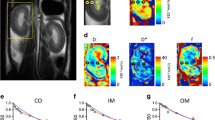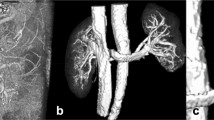Abstract
Objectives
Time-resolved contrast-enhanced MR angiography (4D-MRA), which allows the simultaneous visualization of the vasculature and blood-flow dynamics, is widely used in clinical routine. In this study, the impact of two different contrast agent injection methods on 4D-MRA was examined in a controlled, standardized setting in an animal model.
Methods
Six anesthetized Goettingen minipigs underwent two identical 4D-MRA examinations at 1.5 T in a single session. The contrast agent (0.1 mmol/kg body weight gadobutrol, followed by 20 ml saline) was injected using either manual injection or an automated injection system. A quantitative comparison of vascular signal enhancement and quantitative renal perfusion analyses were performed.
Results
Analysis of signal enhancement revealed higher peak enhancements and shorter time to peak intervals for the automated injection. Significantly different bolus shapes were found: automated injection resulted in a compact first-pass bolus shape clearly separated from the recirculation while manual injection resulted in a disrupted first-pass bolus with two peaks. In the quantitative perfusion analyses, statistically significant differences in plasma flow values were found between the injection methods.
Conclusions
The results of both qualitative and quantitative 4D-MRA depend on the contrast agent injection method, with automated injection providing more defined bolus shapes and more standardized examination protocols.
Key points
• Automated and manual contrast agent injection result in different bolus shapes in 4D-MRA.
• Manual injection results in an undefined and interrupted bolus with two peaks.
• Automated injection provides more defined bolus shapes.
• Automated injection can lead to more standardized examination protocols.




Similar content being viewed by others
References
Morelli JN, Ai F, Runge VM et al (2012) Time-resolved MR angiography of renal artery stenosis in a swine model at 3 Tesla using gadobutrol with digital subtraction angiography correlation. J Magn Reson Imaging 36:704–713
Blackham KA, Passalacqua MA, Sandhu GS, Gilkeson RC, Griswold MA, Gulani V (2011) Applications of time-resolved MR angiography. AJR Am J Roentgenol 196:W613–W620
Schoenberg SO, Bock M, Knopp MV et al (1999) Renal arteries: optimization of three-dimensional gadolinium-enhanced MR angiography with bolus-timing-independent fast multiphase acquisition in a single breath hold. Radiology 211:667–679
Prince MR, Chabra SG, Watts R et al (2002) Contrast material travel times in patients undergoing peripheral MR angiography. Radiology 224:55–61
Voth M, Haneder S, Huck K, Gutfleisch A, Schonberg SO, Michaely HJ (2009) Peripheral magnetic resonance angiography with continuous table movement in combination with high spatial and temporal resolution time-resolved MRA with a total single dose (0.1 mmol/kg) of gadobutrol at 3.0 T. Invest Radiol 44:627–633
Kinner S, Eggebrecht H, Maderwald S et al (2015) Dynamic MR angiography in acute aortic dissection. J Magn Reson Imaging 42:505–514
Kramer U, Ernemann U, Mangold S et al (2012) Diagnostic value of high spatial and temporal resolution time-resolved MR angiography in the workup of peripheral high-flow vascular malformations at 1.5 Tesla. Int J Cardiovasc Imaging 28:823–834
Seeger A, Kramer U, Bischof F et al (2015) Feasibility of noninvasive diagnosis and treatment planning in a case series with carotid-cavernous fistula using high-resolution time-resolved MR-angiography with stochastic trajectories (TWIST) and extended parallel acquisition technique (ePAT 6) at 3 T. Clin Neuroradiol 25:241–247
Notohamiprodjo M, Reiser MF, Sourbron SP (2010) Diffusion and perfusion of the kidney. Eur J Radiol 76:337–347
Schaafs LA, Porter D, Audebert HJ, Fiebach JB, Villringer K (2016) Optimising MR perfusion imaging: comparison of different software-based approaches in acute ischaemic stroke. Eur Radiol 26:4204–4212
Sade R, Kantarci M, Karaca L et al (2017) Value of dynamic MRI using the Ktrans technique for assessment of native kidneys in pre-emptive renal transplantation. Acta Radiol 58:1005–1011
Notohamiprodjo M, Kalnins A, Andrassy M et al (2016) Multiparametric functional MRI: a tool to uncover subtle changes following allogeneic renal transplantation. PLoS One 11:e0165532
Thng CH, Koh TS, Collins D, Koh DM (2014) Perfusion imaging in liver MRI. Magn Reson Imaging Clin N Am 22:417–432
Ronot M, Clift AK, Vilgrain V, Frilling A (2016) Functional imaging in liver tumours. J Hepatol 65:1017–1030
Zhang W, Chen HJ, Wang ZJ, Huang W, Zhang LJ (2017) Dynamic contrast enhanced MR imaging for evaluation of angiogenesis of hepatocellular nodules in liver cirrhosis in N-nitrosodiethylamine induced rat model. Eur Radiol 27:2086–2094
Sanz-Requena R, Marti-Bonmati L, Perez-Martinez R, Garcia-Marti G (2016) Dynamic contrast-enhanced case-control analysis in 3T MRI of prostate cancer can help to characterize tumor aggressiveness. Eur J Radiol 85:2119–2126
Zheng D, Yue Q, Ren W et al (2016) Early responses assessment of neoadjuvant chemotherapy in nasopharyngeal carcinoma by serial dynamic contrast-enhanced MR imaging. Magn Reson Imaging 35:125–131
Chen FH, Wang CC, Liu HL et al (2016) Decline of tumor vascular function as assessed by dynamic contrast-enhanced magnetic resonance imaging is associated with poor responses to radiation therapy and chemotherapy. Int J Radiat Oncol Biol Phys 95:1495–1503
Rischke HC, Schafer AO, Nestle U et al (2012) Detection of local recurrent prostate cancer after radical prostatectomy in terms of salvage radiotherapy using dynamic contrast enhanced-MRI without endorectal coil. Radiat Oncol 7:185
Jost G, Endrikat J, Pietsch H (2017) The impact of injector-based contrast agent administration on bolus shape and magnetic resonance angiography image quality. Magn Reson Insights. https://doi.org/10.1177/1178623X17705894
Arlington Medical Resources (2014) The imaging market guide 2014 (German Edition).
Arlington Medical Resources (2014) The imaging market guide.
Weis M, Sommer V, Zollner FG et al (2016) Region of interest-based versus whole-lung segmentation-based approach for MR lung perfusion quantification in 2-year-old children after congenital diaphragmatic hernia repair. Eur Radiol 26:4231–4238
Weidner M, Zollner FG, Hagelstein C et al (2014) High temporal versus high spatial resolution in MR quantitative pulmonary perfusion imaging of two-year old children after congenital diaphragmatic hernia repair. Eur Radiol 24:2427–2434
Bhargava R, Hahn G, Hirsch W et al (2013) Contrast-enhanced magnetic resonance imaging in pediatric patients: review and recommendations for current practice. Magn Reson Insights 6:95–111
Boos M, Lentschig M, Scheffler K, Bongartz GM, Steinbrich W (1998) Contrast-enhanced magnetic resonance angiography of peripheral vessels. Different contrast agent applications and sequence strategies: a review. Invest Radiol 33:538–546
Essig M, Shiroishi MS, Nguyen TB et al (2013) Perfusion MRI: the five most frequently asked technical questions. AJR Am J Roentgenol 200:24–34
Zollner FG, Daab M, Sourbron SP, Schad LR, Schoenberg SO, Weisser G (2016) An open source software for analysis of dynamic contrast enhanced magnetic resonance images: UMMPerfusion revisited. BMC Med Imaging 16:7
Zollner FG, Weisser G, Reich M et al (2013) UMMPerfusion: an open source software tool towards quantitative MRI perfusion analysis in clinical routine. J Digit Imaging 26:344–352
Ostergaard L, Weisskoff RM, Chesler DA, Gyldensted C, Rosen BR (1996) High resolution measurement of cerebral blood flow using intravascular tracer bolus passages. Part I: Mathematical approach and statistical analysis. Magn Reson Med 36:715–725
Sourbron SP, Buckley DL (2013) Classic models for dynamic contrast-enhanced MRI. NMR Biomed 26:1004–1027
Watanabe Y, Dohke M, Okumura A et al (2000) Dynamic subtraction contrast-enhanced MR angiography: technique, clinical applications, and pitfalls. Radiographics 20:135–152 discussion 152–153
Kopka L, Vosshenrich R, Rodenwaldt J, Grabbe E (1998) Differences in injection rates on contrast-enhanced breath-hold three-dimensional MR angiography. AJR Am J Roentgenol 170:345–348
Zhang H, Maki JH, Prince MR (2007) 3D contrast-enhanced MR angiography. J Magn Reson Imaging 25:13–25
Wang J, Chen LT, Tsang YM, Liu TW, Shih TT (2004) Dynamic contrast-enhanced MRI analysis of perfusion changes in advanced hepatocellular carcinoma treated with an antiangiogenic agent: a preliminary study. AJR Am J Roentgenol 183:713–719
Thng CH, Koh TS, Collins DJ, Koh DM (2010) Perfusion magnetic resonance imaging of the liver. World J Gastroenterol 16:1598–1609
Choi SH, Lee JH, Choi YJ et al (2017) Detection of local tumor recurrence after definitive treatment of head and neck squamous cell carcinoma: histogram analysis of dynamic contrast-enhanced T1-weighted perfusion MRI. AJR Am J Roentgenol 208:42–47
Boll DT, Merkle EM, Lewin JS (2004) Low-flow vascular malformations: MR-guided percutaneous sclerotherapy in qualitative and quantitative assessment of therapy and outcome. Radiology 233:376–384
Krishnamurthy R, Bahouth SM, Muthupillai R (2016) 4D Contrast-enhanced MR angiography with the keyhole technique in children: technique and clinical applications. Radiographics 36:523–537
Wright KL, Seiberlich N, Jesberger JA et al (2013) Simultaneous magnetic resonance angiography and perfusion (MRAP) measurement: initial application in lower extremity skeletal muscle. J Magn Reson Imaging 38:1237–1244
Carroll TJ, Korosec FR, Swan JS, Hany TF, Grist TM, Mistretta CA (2001) The effect of injection rate on time-resolved contrast-enhanced peripheral MRA. J Magn Reson Imaging 14:401–410
Hartung MP, Grist TM, Francois CJ (2011) Magnetic resonance angiography: current status and future directions. J Cardiovasc Magn Reson 13:19
Wetzl J, Forman C, Wintersperger BJ et al (2017) High-resolution dynamic CE-MRA of the thorax enabled by iterative TWIST reconstruction. Magn Reson Med 77:833–840
Dietrich O, Raya JG, Reeder SB, Reiser MF, Schoenberg SO (2007) Measurement of signal-to-noise ratios in MR images: influence of multichannel coils, parallel imaging, and reconstruction filters. J Magn Reson Imaging 26:375–385
Hadizadeh DR, Jost G, Pietsch H et al (2014) Intraindividual quantitative and qualitative comparison of gadopentetate dimeglumine and gadobutrol in time-resolved contrast-enhanced 4-dimensional magnetic resonance angiography in minipigs. Invest Radiol 49:457–464
Ludemann L, Nafz B, Elsner F et al (2009) Absolute quantification of regional renal blood flow in swine by dynamic contrast-enhanced magnetic resonance imaging using a blood pool contrast agent. Invest Radiol 44:125–134
Ludemann L, Nafz B, Elsner F et al (2011) Dependence of renal blood flow on renal artery stenosis measured using CT angiography. Rofo 183:267–273
Warmuth C, Nagel S, Hegemann O, Wlodarczyk W, Ludemann L (2007) Accuracy of blood flow values determined by arterial spin labeling: a validation study in isolated porcine kidneys. J Magn Reson Imaging 26:353–358
Funding
The authors state that this work did not receive any funding.
Author information
Authors and Affiliations
Corresponding author
Ethics declarations
Guarantor
The scientific guarantor of this publication is Gregor Jost.
Conflict of interest
G. Jost and H. Pietsch are employees of Bayer AG.
Statistics and biometry
No complex statistical methods were necessary for this paper.
Ethical approval
Approval from the institutional animal care committee was obtained.
Methodology
• prospective
• experimental
• performed at one institution
Rights and permissions
About this article
Cite this article
Budjan, J., Attenberger, U.I., Schoenberg, S.O. et al. The impact of injector-based contrast agent administration in time-resolved MRA. Eur Radiol 28, 2246–2253 (2018). https://doi.org/10.1007/s00330-017-5178-0
Received:
Revised:
Accepted:
Published:
Issue Date:
DOI: https://doi.org/10.1007/s00330-017-5178-0




